. . . to this channel: great things are just around the corner!
Cellaring: Digging a Hole
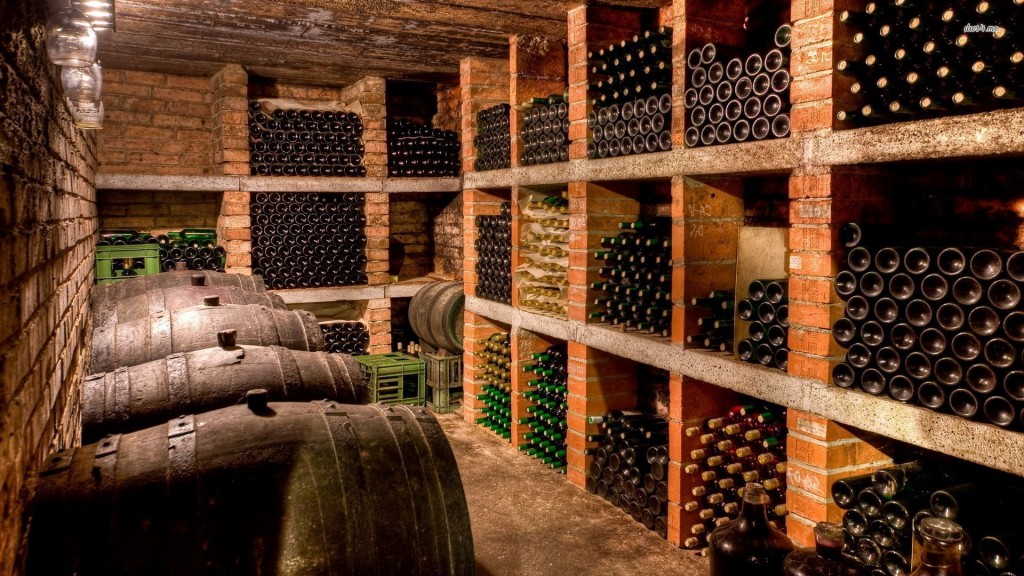
One of the things that’s rarely discussed when the subject of cellaring comes up is the cellar itself. As the name implies, people used to put their wine in a hole in the ground, under their dwelling or winery. As long as human beings have striven to preserve food they’ve known that cool, steady temperatures, combined with moderate humidity would keep fruits, vegetables and meat from spoiling as quickly as it would in other conditions. Wine kept in these conditions not only lasts longer but also improves with time.
Cellars and caves work to conserve and age wine because they offer the perfect combination of environmental factors including:
- Cool temperatures, usually in the 10-12C range (52-55F). Wine held here ages in a very slow and controlled manner. For every ten degree increase in the temperature, the speed of the chemical and biochemical reactions that govern ageing doubles, and some get out of control, causing the wine to die of old age while still young in years.
- Steady temperatures. Variations of less than one degree per day, or five degrees between winter and summer are best. Every time a bottle of wine warms and cools, the wine inside it expands and contracts, alternately pushing and pulling on the cork. Some wine could leak out, or penetrate the cork, and air can enter the bottle. Obviously, neither of these is desirable.
- Darkness—if not complete blackness then at least the absence of direct sources of UV radiation. While wine doesn’t go skunky in minutes like beer does in direct sunlight, it does age quicker and suffers from ‘photodegradation’.
- Humidity—steady, around 70%. Any drier and corks can dry out. Once the end of a cork becomes dry, it wicks wine along just like the edge of a paper towel dipped in liquid. Eventually the wine level in the bottle drops, or the cork dries out completely and crumbles. Too much humidity and your corks will get mould, and your labels will disintegrate.
- No vibration. Wine is a living thing, so constant jostling, thumping and vibrating unsettles it. Store a bottle of wine in an active paint-shaker and it will go bad in only a few minutes. Store it on top of the washing machine, and it won’t take many loads of delicates before it falls apart.
- A ‘clean’ environment. Wine is a food product, and just like not storing angel-food cake next to garlic, you don’t want your precious wine snuggled up to paint thinner, compost or any other food or non-food item that could transfer flavours or aromas.
When asking how long wine will keep – that is, how long you can age it and still have it be drinkable – you’ll find that the answers can become quite complex. Most ageing recommendations tend to be very general, because there are so many variables to consider, including the type of wine, the storage conditions, and the quality of the cork (I’ll talk a lot about corks in an upcoming blog).
What is inside a bottle of wine often has less to do with how well it may age than the external conditions that it will be stored in. Under ideal conditions even inexpensive wines will age for years under a good cork. But those ‘ideal’ storage conditions include the absence of electromagnetic radiation (both visible and UV light), very high relative humidity, a temperature of 11C/52F, not varying by more than 1/10th of a degree over the course of one year, and an absence of any sort of vibration. Any divergence from these conditions could reduce a wine’s ageing potential.
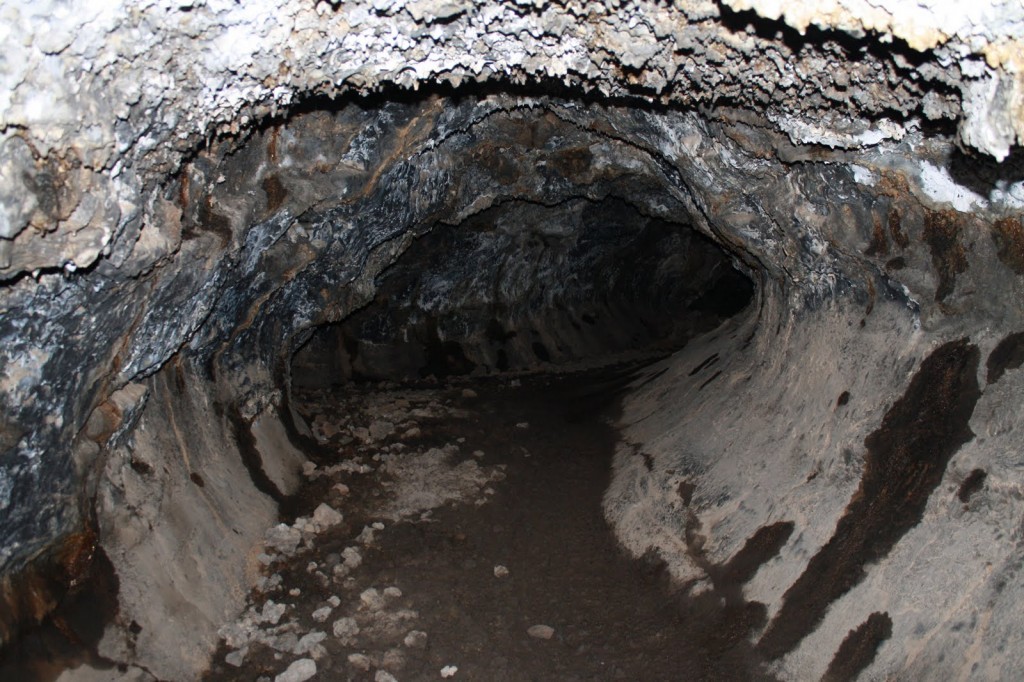
Cool, stable, quiet, humid, dark and clean—sounds pretty simple. But most of us aren’t going to be comfortable digging a big hole under the house, and if our home had all those attributes, it’s a pretty sure thing that we’re living in a cave or under a bridge with trolls. You could buy a fancy climate-controlled wine cabinet, but those can be expensive, especially if you’re making your own wine and building up a good collection. Alternatively, you can make do with what you’ve got on hand, and extend the life and cellaring potential of all of your wine. Easiest is to start by storing your wine in the coolest part of your home, away from direct light sources, off-odours or vibrations.

You can minimize the impact of temperature changes by keeping the wine up against a north-facing wall. Sunlight striking a foundation or the earth around it can cause a temperature flux, so steer clear of south-facing walls. You might also want to build an enclosure around your wine rack if it’s out in the open: this can help diminish convection currents, and increase thermal inertia. The enclosure doesn’t have to be anything fancy; you can create it from things as simple as Tyvek (the foam-board house insulating material), duct-tape and corner brackets.
In colder, drier climates like the north and the midwest, humidity can drop quite low, especially in winter. Too low and your corks will dry out, allowing oxidation and, potentially, leakage. Humidifiers sold for home use are not a good answer; they work too well, and can cause a build-up of mold and mildew in places like the basement, where air circulation is low. It makes more sense to set up a passive humidifier. Essentially this is a pan of water, a clean dishcloth and a cinderblock. Set the pan of water on top of the cinderblock in your wine cellar, drape the dishcloth half-in and half-out of the pan, and tuck the bottom end on top of the block. This will allow the towel to wick the moisture out of the pan and increase the evaporation into the air. The cinder block will hold any excess moisture and release it slowly, helping keep the humidity steady, even in a cellaring area a large as a thousand cubic feet.
Some wines are more susceptible than others to poor storage conditions. In general, white wines–particularly off-dry wines and Champagne – are frailer than reds. Grape variety can also make a difference to how well the wine does in storage; so you would find that a robust variety like Cabernet Sauvignon is generally more resilient than delicate one like Pinot Noir.
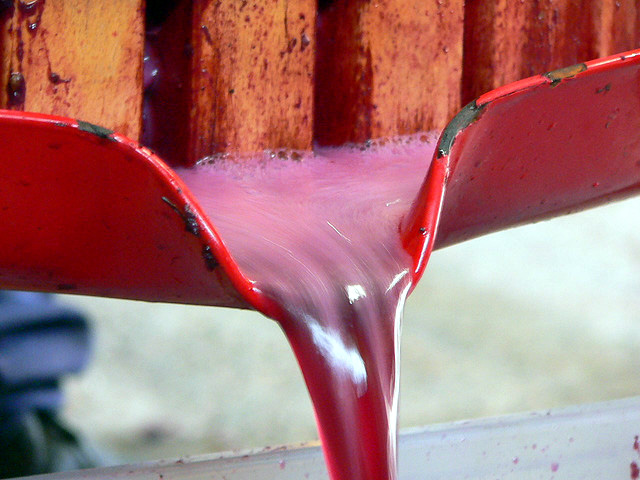
With a newly bottled wine, it’s tempting to start consuming it right after bottling. While there are many wines that can be consumed young and be everything you want them to be, if you really would prefer to maximize your wine’s potential, a little time in the bottle can make an enormous difference. Most red wines begin life with obvious fruity aromas and some degree of astringency or bite, but with ongoing ageing, they develop softer, gentler, more complex aromas and flavours. The wines become richer as the fruit mellows and as the astringent tannins relax and contribute to the body and character.
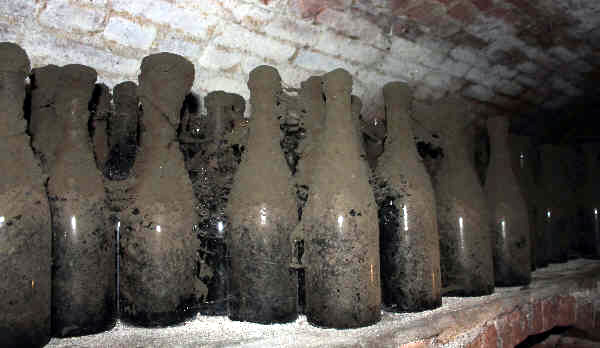
Cellaring wine used to be a rich man’s game. In centuries past, only wine merchants storing stock for future sale, or the very wealthy could afford to purchase age-worthy wines in large volumes, and then wait as the years passed to sample them as they approached their peak. The French used to say that you didn’t buy Bordeaux for yourself, you bought it for your children, while you drank the wine your father had bought. Things are a little easier with modern wines. Most of them are designed to be more drinkable sooner and even a moderate amount of cellaring will help bring out their best.
Summertime, and the Livin’ is Busy
I’ve had a busy couple of weeks: between staying ahead of my garden and keeping up with writing projects and clients I haven’t had a lot of free time.

Fortunately I’ve got a break: I’m flying off on an exciting big city adventure! Toronto here I come. Well, GTA, here I come . . . I like Toronto, but in 20 years of travelling there several times a year, I think I’ve only actually spent a total of four days in the city, so it still seems like a strange place to me, but business is business and travelling for pleasure never seems to take me to the exotic places in my own country.
On the other hand, all this will be waiting for me when I return!

I’ve got some cool new stuff in the pipeline: I’m shooting video, but while I’m great in front of the camera, I’m not as competent behind it. I hope I’ll have something better than a blooper reel next week.
I’m also bent on getting some all-grain brewing done. One of my current projects is to get my full brewing setup back on-line, and it’s happening. I’m drilling holes in pots, connecting mash screens and generally planning stuff up–wait until you see my new grain grinder (one of the video topics to come).
Beyond that, as always I’ve got a million words to write and many other promises to keep. Hurray for self-employment, my boss never lets up on me!
Whoops! Time to pack, and I’ve got to water the gardens before I leave.
Why to Filter
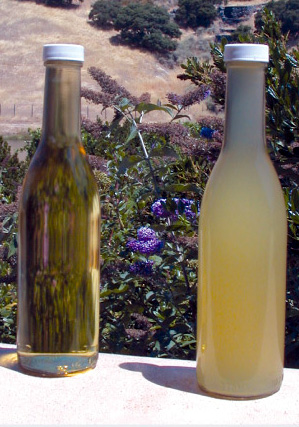
You can find any number of articles on filtering wine—a quick search on the inter-webs yields something like forty-four million hits—and probably double that number of opinions on the topic. Winemaker magazine has run many articles on filtering, including an excellent one by their regular kits columnist, what’s-his-name. So there’s no dearth of information on the topic.
What there is, in fact, is a surfeit of information on the mechanics and execution of filtering, the how-to side of the process. What you don’t see very often is the other side, the philosophical, the ‘why-to’ side, or the ‘why-not-to’ side. That’s up three sides now, making it perilously close to geometry, but there are a bunch of issues surrounding filtering that come up over and over again in winemaking discussions.
- Do I have to filter my wine?
- What are the benefits to filtering, long and short-term?
- What are the potential downsides to filtering?
- Does filtering strip colour, flavour or aroma from a wine?
- Do I have to use fining agents if I’m going to filter anyway?
- What’s the best filter to use?
With these questions usually come some very strong opinions. In some cases the strongest opinions come from people who’ have a little knowledge and the proverbial danger that comes with that, but opinion isn’t limited to them: some of the most knowledgeable winemakers, making some of the most expensive and well regarded wines in the world have very strong opinions as well, and some of them directly contradict each other.
In fact, the Oxford Companion to Wine (full disclosure: I’m a contributor to that august tome) even lists filtration as a ‘controversial’ subject. From the OCtW:
Filtration of fine wines is a controversial issue. While it may be a necessity for ordinary commercial wines, it is widely thought that too heavy a filtration can indeed rob a fine wine of some of its complexity and capacity to age, not to mention some loss of colour, particularly a red wine as subtle as some fine red Burgundy. Some commentators and winemakers claim that filtration of any sort is harmful: it is not uncommon to see the term ‘unfiltered’ used as a positive marketing term.
Gadzooks! Loss of complexity! Loss of capacity to age! Any filtering harmful! Is there no upside to filtering? Well, maybe, as the entry goes on to say:
However, the possible negative effects of filtration should be weighed against the very real risk of microbial contamination or instability, particularly where perfect storage or transport conditions cannot be guaranteed. An unfiltered wine throws a much heavier crust, or sediment, than one that has been filtered.
What to think? Well, first of all, keep in mind that the venerable Oxford is almost exclusively concerned with commercial winemaking. Out of thousands of entries there’s only one on home winemaking, and until I re-wrote it, it never mentioned kit wines and only devoted half a sentence to ‘concentrate’, so their opinion might be a little fluffy around the edges, not close to the rich, meaty centre of winemaking where us consumer winemakers make our bones. We don’t need a marketing department to tell us how our wine tastes when there’s a perfectly good glass right there at our elbow.
Second, I’m discussing only the filtering systems and processes available to home winemakers–yes, cross-flow filters are like amazing magic boxes that can accomplish astounding feats of clarity, but until they drop below $20,000 and require less than 100 gallons to prime the pump, they’re not going to be of any use to real, live home winemakers.
1) Do I have to filter my wine?
Nope, at the end of the day filtration isn’t necessary. In the 10,000 year-plus history of winemaking, filtration has only been possible in the last century or so, after the advent of industrial processing and a firm understanding of the microbiology of wine (thanks, Louis Pasteur!).
With modern winemaking technology, wine kits come almost completely free of suspended solid material. Precisely calculated fining agent use, in the form of bentonite, Chitosan, isinglass and kieselsol, deals with any colloids (like proteins) and 99% of the yeast in a very short time, leaving the wine clean and quite clear.
So you don’t have to filter if you a) don’t have a filter, b) don’t want to go to the trouble, or c) don’t care. You’ll still have clear, drinkable wine.
2) What are the benefits to filtering, long and short-term?
In the short term, you will be able to expect what the industry calls ‘star bright’ wines. I said the finings leave the wine clean and quite clear, but not completely clear. After fining there can still be tens of thousands or even millions of yeast cells still floating around in your wine. There can also be unstable colloids floating around. These materials will take the edge off of clarity. There are two analogies that fit pretty well here. First, if you’re an eyeglass wearer, you know well that you can look through your spectacles and see clearly almost all of the time. But if you take them off at any random interval and have a look at the lenses, they can be pretty smeary and icky. A quick polish will allow you to see more clearly and accurately.
The second analogy works even for the perfectly-sighted: the difference between a well-fined wine and a filtered wine is the difference between a freshly washed car and a freshly waxed car. They both look good, and they both look shiny, but the waxed car really looks spectacular, and is much more appealing to most people who will look at it.
Long-term you can look forward to greater stability. Stability in this case is defined as the wine not changing in flavour or appearance during storage in the bottle. As the Oxford notes above, there are issues with microbiological stability and with deposits or sediments in unfiltered wine.
Microbiological stability merits a mention, but not too much concern. Since all kit wines are pasteurised at packaging, there are very few potential contamination organisms that will show up in your batch. The one place where filtration provides extra protection is for wines that have residual sugar, or sugar added post-fermentation via ‘F-packs’, ‘sweetening packs’ or ‘Süsse-reserve’. Putting these wines through a filter will help reduce the yeast population below the level at which they can ferment sugar into carbon dioxide and alcohol, keeping your sweet wine from turning into fizzy, bottle-shattering dry wine. Toss in a bit of sorbate to keep the remaining yeast from breeding back to culture strength (from where they can start making fizz-and-booze again) and you’ve got increased stability over the long term.
Another long-term benefit is in the appearance of the wine over time. Deposits and sediments can (and indeed, almost always will) form in fined but unfiltered wines over a long enough timeline. These deposits show up in reds as a thin layer of purple or red material on the bottom of the bottle or in a line along the side. In whites they appear as white-ish or beige. They can be dead yeast cells, polymerised phenols (a kind of tannin that’s gooped up and settled out) or (in reds) pigmented tannins. Pigmented tannins occur when tannins bind with anthocyanins.
If you’re getting a sore head from all the polysyllabic terms here, tannins are (mostly) the compounds in red wine that give astringency and mouth-feel, and anthocyanins are colour compounds. The process is insanely complex, from a chemical point of view, but when they bind together over time they can settle out as a very fine, almost paint-like layer of muck.
Filter, and you’re not likely to see any fall-out in your bottles over the medium (three to 5 years) term, and much lower levels after that.
3) What are the potential downsides to filtering?
Surprisingly, they’re pretty much the same as the downsides for any handling or processing operation in winemaking, from racking to fining and stabilising: the chance that you’ll introduce a contaminant or too much oxygen into the wine, causing an infection or oxidation.
Both of these are easily avoided. First and foremost, as in all aspects of life, with winemaking cleanliness is next to goodliness. Every piece of equipment that comes into contact with your wine must be clean—free of visible dirt or debris—and sanitised—treated with a chemical sanitiser to kill or suppress bacteria. Filter machines often have a lot of hoses, clamps, crevices and irregular surfaces, so be sure to disassemble them and give ‘em a good scrubbing, treat them with sulphite or other suitable winemaking sanitiser/suppressant, and rinse the dickens out of them.
As for oxygen, filtering agitates wine as it travels through pumps, hoses and filter media, but doesn’t necessarily introduce oxygen into it. Most filter set-ups are positively pressurised, meaning they use a pump to force wine down a hose and through the system. If there is a leak somewhere in the filter between the pump and the carboy the wine is going into, it’s going to squirt wine out, not suck air in.
The only real danger that using a filter will add oxygen is if you run the output hose down the side of the receiving carboy, where it can fan out and expose an enormous surface area to oxygen pick up—gently place the output hose directly into the bottom of the carboy instead, and allow the tip to submerge as it fills, keeping everything as quiet as possible.
What you really have to watch is that there is sufficient free sulphur dioxide (metabisulphite) in the wine to protect it during handling. This will be the amount included in the kit, added in full, at the appropriate time. Just a hint: if your kit has a note in the instructions about optional added sulphite for ageing terms over six months, add it before you filter, even if you’re going to drink the wine up sooner. This is prudent because the very small extra amount the instructions ask for, usually a quarter-teaspoon, which is less than a gram and a half, won’t change the flavour or aroma of the wine, but will make sure the extra handling that filtering represents doesn’t cause harm.
3) Does filtering strip colour, flavour or aroma from a wine?
Yes and no. But mostly no, and the aroma and flavour part is strictly temporary, and the colour part is good. I’ll explain, but first I’ll qualify: I’m telling you the strict truth, for people using filters available to people making their own wine at home. You might read contradicting opinions somewhere else but keep in mind two things: first, some of those opinions will be from people who have access to commercial filtering equipment and processes, which can be vastly more effective at removing things from wine. Second, they’re probably wrong.

Colour
The kinds of filters available to home winemakers operate on the micron scale, with the tightest, most efficient filters stopping somewhere above 0.2µ, about two-tenths of a micron. Your typical yeast cell is around 0.45µ, and a freshly budded daughter cell (they grow up so fast, sniff) is down at the 0.2µ mark. It’s far more common to see filters that allow the passage of material as large as two to four microns in size.
Colour molecules, the aforementioned anthocyanins, are not on the micron size. They are so very much smaller that their structure can’t be seen with a microscope. They’re so tiny that in fact they will sail straight through a filter pad or cartridge entirely unimpeded—you can’t filter them out.
Which begs the question, for anyone who has ever used a filter on a red wine, why do the pads come out stained with colour? Those stains aren’t pure, happy colour compounds: they are colour compounds that have already bound to other kinds of goo in the wine. When bound to tannin, they’ll fall out later as a deposit (mentioned above) and when bound to a colloid, they’ll fall out as sediment. This is a vast over-simplification (I specialise in those) but the core truth is that you cannot filter out colour with civilian filter pads—not any colour that wouldn’t fall out on its own anyway.

Flavour and Aroma
What goes for colour compounds goes for flavour and aroma: they’re just too small to stick to filter pads. And yet anyone who has ever filtered a wine has almost certainly noted that it tastes notably less distinct and aromatic post-filtering.
This is a complex phenomenon wine, referred to under the catch-all phrase ‘bottle shock’. A couple of explanations are popular. First, a dose of sulphite (usually added at bottling or filtering) mutes the flavour and aroma of the wine. Seems plausible enough, and easily observed by anyone who has ever tasted a wine right after sulphiting it.
Second, if a wine gets a significant dose of oxygen during handling, some of the oxygen can combine with ethanol and other alcohols to form aldehydes, which really cramp a wine’s aromatic styling. The good news is, both of these conditions are temporary. Give the wine a few weeks rest, and often only 24 hours will do it, and the aromas and flavours snap back into focus, good as new, with filtering not to blame after all.
I said earlier that anyone who disagrees with me is wrong. I still think that, but there is a way in which they’re reaching towards a sort-of truth about filtering and removing desirable compounds from wine. When a wine, particularly a red one, is very young, you want to get it off of the gross lees and then the fine lees quite rapidly, with several rackings taking place in the first year. This prevents yeast cells from decaying and transferring their flavour into the wine, and prevents all kinds of grape pulp and vineyard muck from getting funky as well. But you don’t want to strip the wine clear of all compounds right away. There are extremely complex chemical reactions and biochemical processes that can benefit from the presence of solid material dissolved and suspended in the wine as it goes through elevage (upbringing).
That doesn’t add up to an indictment of filtering, however, it just means that you should filter as the last step in your process before you go to the bottle—too early and you might cheat an ageing/elevage process of some compounds that could help.
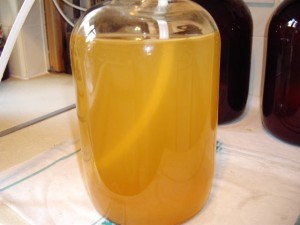
5) Do I have to use fining agents if I’m going to filter anyway?
YES! You can’t filter a wine that isn’t already really, really clear. The amount of yeast and good in suspension would clog a filter up so badly that you’d spend more than the cost of the wine kit itself in filter pads before you got to the end.
If we go back to the car analogy, you can’t wax a car that hasn’t already been washed thoroughly: waxing isn’t to remove dirt it’s to put a final polish on the car. Filtering isn’t to clear wine it’s to put a final polish on it right before bottling.
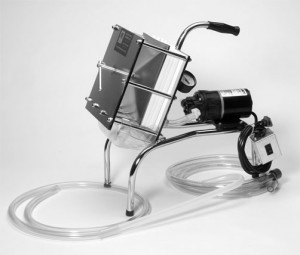
6) What’s the best filter to use?
The most common filters available to home users are depth filters with plate and frames and positive displacement pumps. This means they’ve got some kind of structure of layered plates that trap cellulose pads in between them and the wine is forced through the pads by a pump that pushes it down a tube. There are others, including ones that use a vacuum to pull the wine through a plate and frame, membrane filters that use a setup identical to home water-filter cartridges, either with a pump or a vacuum, and even manual ones that rely on gravity to dribble the wine through a pad set-up.
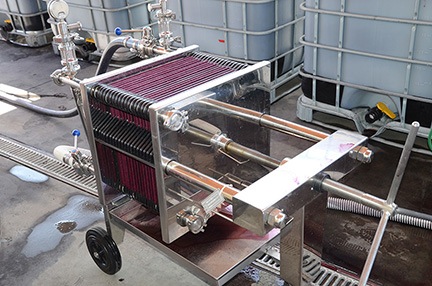
Commercial wine filters can be much more complex, but most of them you can’t afford to switch on for less than a few hundred gallons of wine—a single 6-gallon/23 litre batch wouldn’t even prime some of the pumps. Things like cross-flow filters, centrifuge decanters, pressure leaf filters and rotary drum vacuum filters are amazing technology, but for most of us rather like swatting a housefly by dropping a mountain range on it.
I’m big on positive displacement plate and frame filters. They’re simple, very easy to set up and use, widely available, and ideal for our purposes. They come in sizes ranging from just smaller than a toaster, suitable for one or perhaps two batches at a go, to models big enough to do 20 gallons in a reasonably short time, and others intended for higher volumes that can filter a carboy sparkling clear in under 30 seconds. I own examples of all three, and they’re fine machines.
They’re called depth filters because the pads used in them act like a sponge, soaking up the wine and wringing it out clean on the other side, with the ‘sponge’ part retaining the cloudy goop. This makes them capable of taking quite a bit of muck out of the wine before they clog up. When they do, you toss ‘em out, because they’re cheap.
There’s no objection I can think of to using a vacuum system, set-up to pull wine from one carboy to another, with a plate and frame in between, other than an incremental increase in complexity while using it—if you’ve got a vacuum pump, more power (power vacuum?) to you.
But I’m not big on membrane filtration. Filter cartridges are best suited to water or air filtering, where they have to deal with fairly low levels of material. The issue is that membrane filters act as a screen-door, rather than a sponge. They usually have a fan-folded cartridge that almost behaves like a two-dimensional object. Anything larger than the holes in the membrane piles up on one side and clear wine passes through.
That is, until the cartridge membrane is completely blocked: because it’s a screen, there’s no depth to soak up lots of goo. After that you have to change it, or clean it before it can filter more wine. This can be done, but handled carelessly, as by backflushing with too much pressure, cartridge integrity can be compromised, allowing material to pass through.
And cartridges are much more expensive than filter pads. There are inexpensive examples, but they won’t be as effective or as strictly rated as more expensive ones. There’s not enough room in this article to discuss the difference between nominal and absolute micron ratings, but when you buy inexpensive cartridges, you’re getting pretty much what you pay for. It’s kind of the ‘toner model’ of computer printers—the money in cartridge filter systems is made in replacement cartridges, not in the actual system itself, so that’s where you pay if you purchase one.
It should be pretty obvious after these points that I’m a fan of filtering, and mostly with positive displacement depth filters. But you would be surprised how often I don’t filter. A lot of the time I’m too lazy. My reds sit for a couple of years before I get around to them, and by that time I’m out of wine and in a hurry, so I just get them in the bottle and pretty immediately into the wine rack. I’m more likely to filter whites, but even then my slack attitude towards a production schedule has me bottling without filtration at least part of the time. But with that, I have to put up with the occasional deposit in the bottle, which is fine for me, but puts a crimp in giving away bottles or sharing with others.
In the end, whether or not you should filter should come down to your own preference, your tolerance for extra processing steps, and the attitudes of those who will be consuming the wine—but don’t worry in any case: filtering won’t hurt your wine in any way, and can help improve the aroma and maintain its appearance over time.
Shooting Automatic Weapons Underwater, Stirring Wine Kits Above

Making wine from a kit is an awesome way to become your own personal vintner. The kits provide all of the ingredients and materials to turn out a couple of cases of wine in less than a couple of months, and the instructions are complete, clear, and very easy to understand.
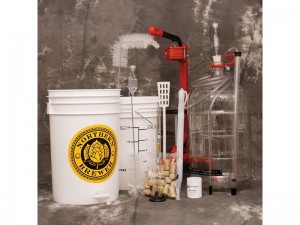
Ahem. Given that I wrote most of the kit instructions out there over the years, it’s understandable that I’ve got a positive feeling about them. However, I’m aware that not everyone thinks they are as clear as they could be, and it almost always seems there’s too much detail or not enough.
One area where it’s difficult to convey the exact intent is in stirring. When you reconstitute the kit on day one, it’s important to stir hard enough to mix the juice thoroughly–easy enough. On fining/stabilising day stirring is even more important: you have to agitate the wine hard enough to disperse the trapped carbon dioxide gas. If you don’t, not only will the wine be slow to clear, it will be fizzy at bottling time and will always have a slightly off aroma and flavour–that trapped CO2 will carry a bit of other, nastier gases with it, like hydrogen sulphide and dimethyl sulphide: rotten eggs and cooked cabbage respectively.
In actual fact, you shouldn’t ‘stir’ your wine kit. Stirring merely moves the wine around, like a lazy kid on a merry-go-round. You need to agitate the wine hard enough to get all of the gas out.
This is why I’ve always recommended a drill-mounted wine whip.
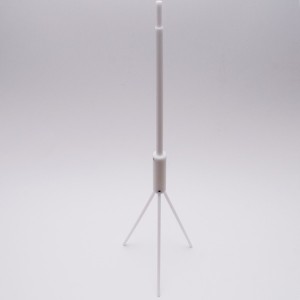
To use one of these, once it’s sanitised, the top goes into the chuck of a high-speed reversible hand drill (plug-in kinds are best–those battery jobs always seem to be flat when you need them) and the three prongs are folded and inserted into the carboy or bucket. When you’re de-gassing, you always use the whip at full power, except at the very beginning, when you test to see how much gas saturation the wine has. Everything is fun and games until you’ve got Krakatoa Cabernet fountaining out of the carboy and onto the ceiling. Sequence goes like this:
- Quick, one-second experimental stir. If things don’t instantly spray out of the carboy, proceed to step two.
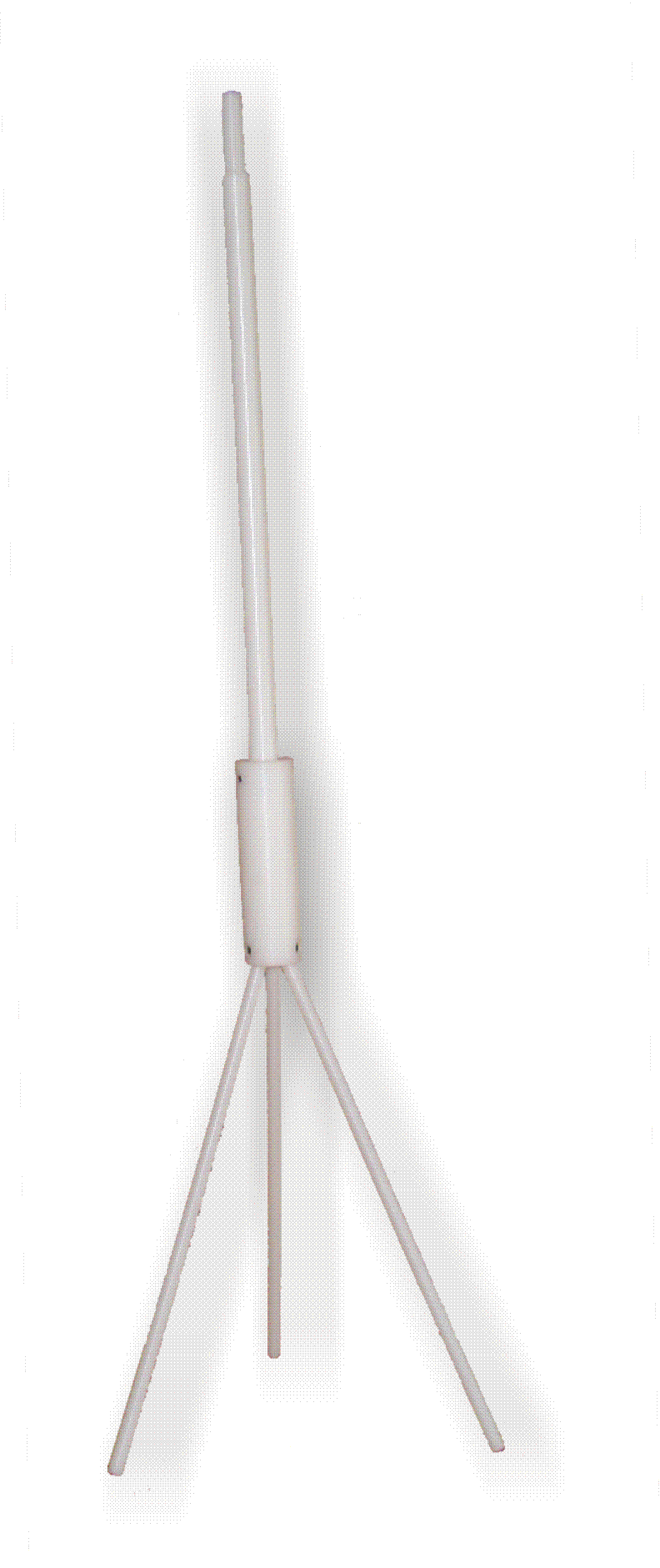 Go absolutely full power, and keep it there.
Go absolutely full power, and keep it there.- When the wine begins to swirl up the sides of the carboy, looking like it’s going to overflow, immediately reverse direction, and go full power, against the flow of wine.
- You’ll see the wine stop climbing up immediately. Keep it on full until it starts to climb up again, and repeat the reversal–full power.
- Repeat this twice more, always full-on.
If your wine is not de-gassed at this point, it’s because the gods of fermentation hate you, or your wine was not finished fermenting, or your wine is very cold and it’s a bright sunny day (high barometric pressure). But I’m betting on some kind of divine divine vengeance because I’ve never needed more than three spins each way, less than two minutes altogether.
The point of intense agitation is to cause tip-vortex cavitation in the wine, at the tips of the whip. Cavitation happens when you vaporise a liquid by exposing it to decreased pressure. This vapour is the same thing as steam from a boiling kettle, but doesn’t involve heat–just the pressure reduction.
This is a little hard to visualise, but it obeys the laws of thermodynamics perfectly. The most common place to see cavitation is in boat propellers. Spin them up too fast and they won’t push the boat, because they’ll be in a cavity of water vapour, whirling about and doing nothing (unless they’re special supercavitating propellers, but let’s pretend they don’t exist).

For the last couple of decades I’ve been telling people about cavitation by quoting the 1990 movie The Hunt for Red October. It’s a techno-thriller about Soviet-era espionage and features Sean Connery as a Russian sub commander with a ridiculous Scottish lisp. In the fateful scene the commie sub tries to make a run for it but the propellers spin too fast and they cavitate. Why this is a crucial plot point is that during cavitation, when the vapour bubble collapses (as all good bubbles eventually do), they slam shut with such violence that they ‘hammer’ the water, which makes a large enough noise to alert enemy sonar operators. It’s this slamming/hammering effect that literally blasts carbon dioxide bubbles out of suspension, and why stirring any slower is almost useless for de-gassing.
(Not only does this make a really great echo for sonar operators who might be looking for Rooskies, in extreme cases it can cause sonoluminescence, a burst of photons [light] from the bubble collapse. You know why it does this? Good, that makes one of you. Nobody actually has a lock on the theory of why a collapsing bubble in a liquid makes light. It just does. Probably quantum, or Vogons or something.)
That analogy worked for the first decade, less well for the next, and now it doesn’t carry any weight with people under the age of twenty-five, who never lived with a Soviet Union, just a big old Russian crazy-quilt of ongoing collapse and oligarchic wealth transfer. I’ve been trying to find a new handle on the moment, and Just This Day I found one, courtesy of Smarter Every Day. If you’re not familiar with them, you’re welcome. Destin and his support crew demonstrate scientific and physical principles in extremely clear ways and film them (sometimes at twenty thousand frames per second!) and post them on YouTube. If you’re a science geek/covert nerd like me, that link is going to suck up a lot of your time for a while. My apologies to your family.
Here’s the video, in which they shoot an AK47 in an (empty) swimming pool.
It’s over ten minutes long, and while I urge you to watch all of this fascinating and brilliantly executed demonstration, if you’ve got a cake in the oven or are being chased by zombies, you can fast-forward to 4:30 for the most excellent illustration of the hammering effect of the bubble collapse. The AK47 bullet travels through the water, pulling a vapour bubble behind it. The bubble collapses, and as it does, you can actually see the intense shock wave that the collapse produces. And it hammers so hard, it rebounds and produces a secondary shock as well!
Imagine what being shot with a Russian carbine would do to a carbonated beverage. Yep, it would really go a long way to de-gassing it. And that’s the same kind of action you get when you stir your kit wine with a whip at full speed, only with less bullets and collateral damage.
The question could come up, ‘Why are you so hot on that three-prong whip, Tim? It’s much more expensive than the other drill-mounted stirring whips on the market–do they pay you?’
Alas, I only wish I got a commission on those things. I’ve been pushing them like a madman since I saw the first one. It’s purely a functional thing–the other models of whip work, but they’re not quite as effective, for a couple of reasons. First, most of the other whips cannot take the force of being reversed under full power. Their stubby little blades shear right off, or the hook-ish shaped ones twist themselves into a knot.
Second, if it’s the speed of the tip of the whip/propeller that makes the vortex appear, then spinning a set of three whips spanning a circle nearly a foot across at the same RPM as a wee stubby little set of blades will make those long whip-tips travel immensely faster–they have to to cover the same complete circle as the wee little ones, so they’re hustling much faster.
So there you have it. Please don’t fire an assault rifle into your carboy. Instead, get a drill and one of those amazing three-prong whips and you’ll be out of gas faster than a ’59 Caddy.
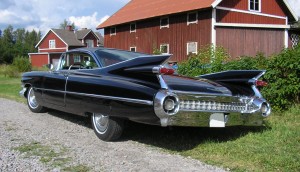
Beer Gadgeteer and the Fabulous Fizzbuster
File this one under ‘Oh lord, what now?’
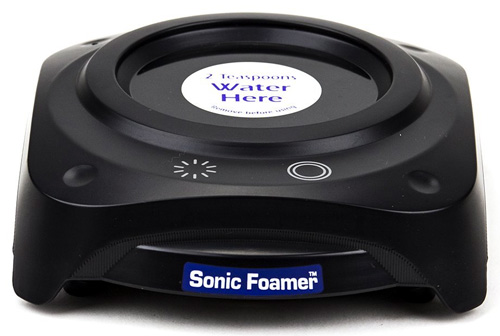
If you’re having trouble guessing what the gadget is, don’t feel bad: other than the strange label (which makes it sound like it’s for shaving cream or perhaps for cartoon hedgehogs) there’s nothing about it that suggests a function. My first thought was that it was for rewinding DVD’s. However, according to the website,
Using ultrasonic vibrations, the Sonic Foamer excites the gases in your beer for an amazingly creamy head.
Oh. Okay. I can do the same thing by pouring the beer between two glasses, or stirring it with a spoon for a second, but sure, make an expensive gadget for stirring-impaired people, no problem. But why do they think you should stir it up and make a foamy head?
The aroma of a beer is released as the bubbles in the head pop.
No, that is not how the aroma in a beer is released. The aroma in a beer is released when the low-weight molecular compounds that comprise the bouquet and aroma of the beer travel from the liquid and travel through the air to the receptors in your nose. Bursting bubbles in the head aren’t especially relevant to the process.
Certainly, agitating the liquid helps increase the amount of these compounds released–that’s why wine tasters swirl their glasses. And beer judges do the very same thing, swirling sample glasses to chase out elusive aromas.
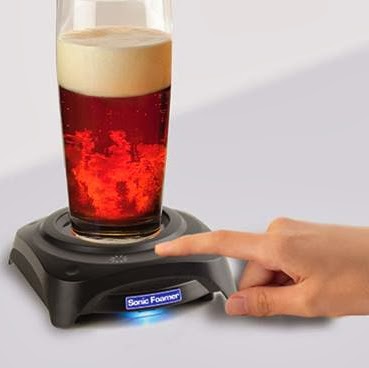
So it’s a gadget that’s a solution to a problem that exists in the minds of their marketing department. C’est la guerre. But even though their claims are malarkey, I can think of a brilliant use for one of these doohickeys: degassing excessively foamy beer.
This is a pet peeve of mine. Anyone who has gone on a pub crawl with me has had to watch me restlessly pour my beer between two glasses to chase off three-quarters of the carbon dioxide gas before I drink it. I don’t do it to all styles, because some styles like wheat beer, Kolsch and light lager need sufficient volumes of CO2 for proper mouthfeel.
‘Volume’ is the science-word for amount of gas in a liquid solution. The actual sciencey part of beer carbon dioxide saturation is governed by Henry’s Law and a bunch of frightening math. For our purposes, one volume of CO2 is the equivalent of one litre of carbon dioxide gas dissolved in one litre of beer at one atmosphere of pressure (sea-level, more-or-less). If you’re not metric, a litre is about a quart. If you’re having trouble conceptualising what this means, if you drink a litre of one-volume beer, you’re going to belch out one litre of burps, eventually.
A classic Czech Pilsner will have 2.3-2.5 volumes, very appropriate for that style, while Standard Western Industrial Light Lager will have 2.7+ volumes. That’s only fair since it doesn’t generally have any other character to speak of.
Where this all falls apart for me is ales. Classic British pale ales will have 0.75 to 1.3 volumes. If you’re a fan of these beers, they drink smooth and taste wonderful, and you don’t have to belch like a foghorn if you decide to have several pints. American ale styles on the other hand, have as much CO2 as lagers. American Pale Ale clocks in at up to 2.78 volumes, making the much heavier, more flavourful style of beer as gassy and belch-worthy as lawnmower S.W.I.L.L.
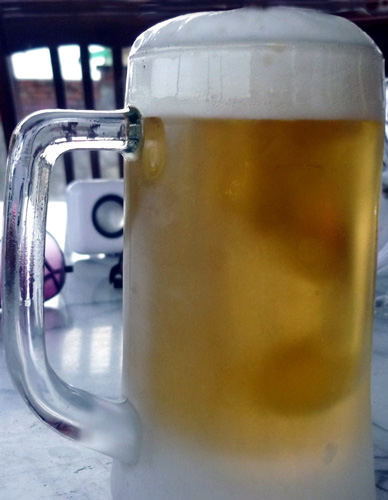
For my palate, this destroys the flavour, mouthfeel and enjoyability of the beer. CO2 gas in solution produces carbonic acid, a flat, bitter tasting substance which dulls the bright flavours in the beer, and it makes me feel bloated and belchy after only a couple of pints. I keep questioning brewers as to why they continue to overcarbonate their beer like it’s a practical joke drink but the standard reply is, ‘That’s what consumers expect’.
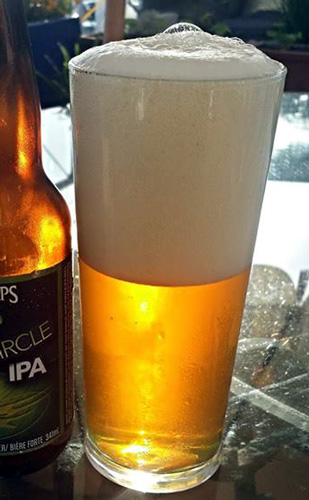
Some day I’m going to punch those consumers in the snoot, because they just don’t seem to know what’s good for them. If they tried the beer at a proper carbonation level they’d find it much more interesting and drinkable. Maybe some day. Until then I’ll have to content myself with making my own beer and carbonating it to the levels I like, degassing commercial beers right at the bar, and complaining about how everyone is wrong about everything except me.
But I’m thinking I need to order me one o’ those de-foamers to do a little testing . . .
Winemaker Conference 2014

I’m heading to Virginia next week for the Winemaker Magazine 2014 conference, June 5-7 at the fabulous Lansdowne Resort in DC’s ‘Wine Country’. I haven’t missed a conference since the very first, in Monterey back in 2008. I love the Winemaker conference: even though I have to work during the conference I get a chance to meet old friends, find out how their wines are coming along, see how they’re doing and generally catch up with a great bunch of people. In all these years I haven’t met one winemaker I wouldn’t be happy to have as a guest in my house. I think there’s something about taking winemaking seriously that self-selects for thoughtful, happy folks.
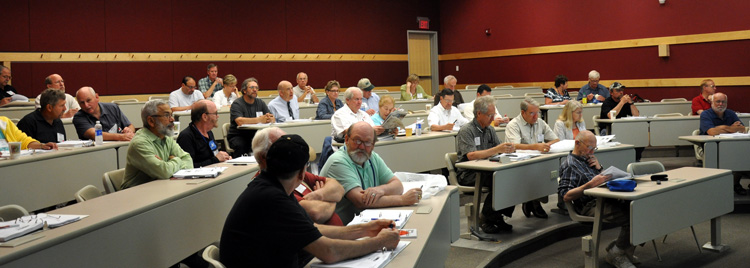
This is going to be an especially cool year. I’m teaching a one-day Winemaking Boot Camp. It’s going to be an intensive one-day course with a lot of hands-on trials of advanced equipment, for bottling, transferring, processing and testing. It was a bit of a scramble pulling it all together since my previous corporate sponsor is no longer involved with the conference, but with the help of some friends (more on that soon) and the understanding and largesse of Winemaker Magazine (thanks Brad!) I think I’ve put together a really outstanding program.

The really cool part is going to be on post-fermentation correction of wine character. This is the secret stuff that in my former life I was obligated to discourage, since it wasn’t part of the program for our products–the companies stances have always been that wines made from kits should be considered complete in themselves. While this is technically true, that still leaves an awful lot of room for tweaking kits, especially now that the toolbox and palette of professional winemakers is now available to retail consumers! It’s going to be a ton of fun!
Well, if I get that case of wine across the border, that is . . . hmm.
You can follow me on Facebook and Twitter for ongoing updates ( #WineMagConf) from on the ground.
Also, as always bookmark this page and check back: good news is always just around the corner!
Craft Beer, Crafty Yeast
See the little nuclei
Bursting full of information
There’s a need to regulate
Bring it down to cells and plasma
Tell you what they’re gonna do
Started doing it already
Got to find something new
Looking for it in genetix
Found a new game to play
Think it’s impossible to lose
Messing round at playing God
Easy way to play genetix
Stranglers, Genetix, from the album Raven
There’s nothing like a good Stranglers tune to warm the heart of an old punk/beergeek. Which brings me to an interesting article from the New York Times, Strange Brews: the Genes of Craft Beer.
White Labs, an important supplier of yeast to both the craft and the homebrew market, is engaging in an amazing effort to sequence the DNA of brewing yeast. Currently they’re at 240 strains, but there are thousands out there to go. They’re partnered with a biotech lab that’s a joint venture between the Flanders Institute for Biotechnology and the University of Leuven, Belgium.
So why sequence the yeast? After all, it’s one of the best-understood and most-studied organisms on the planet. From the Times article:
By getting a line-by-line reading of the 12 million molecules that make up the DNA of each yeast, Dr. Verstrepen said, the researchers will be able not only to tell how closely related two yeasts are (is Sam Adams’s closer to Stone’s, or Sierra Nevada’s?) but to answer other important questions: which breweries started with the same strains of yeasts, how these organisms evolved over time and, of course, how all of it translates to taste.
“Yeasts can make over 500 flavor and aroma compounds,” said Chris White, the founder of White Labs, affecting a beer’s alcohol level, clarity and texture. But while brewing yeast is one of the best-studied organisms in molecular and cell biology, exactly how its genes translate to brewing properties is still poorly understood.
By comparing the DNA of hundreds of yeasts, along with information on how they act and brew differently, “we’ll have a unique window into the genetic code,” said Mr. Prahl, who is leading the experiment at White Labs. He is comparing each yeast’s sequencing information with brewing data on more than 2,000 batches of beer — including the four he was tasting.
This is super-cool. When I started making my own beer three and half decades ago, there were maybe five strains of yeast available. Not much changed for decades, but as homebrewers evolved into craft brewers, the demand for new strains, and pure strains increased, until today we have hundreds of distinct and different yeast to choose from.
Yeast is responsible for more that 70% of the flavour in beer–you can produce a batch of wort (the word for unfermented beer), split it into ten lots, ferment each lot with a different strain of yeast, and at tasting time you’d swear each one was completely different beer, from different brews. By learning the specific genes that control flavour and aroma production, and crossing yeast to maximise desirable characteristics, they’re going to be able to manufacture yeast that not only make fabulous tasting beer, but also yeast that are less environmentally demanding, more stable and easier to use/more flocculant/better fermenting, etc.
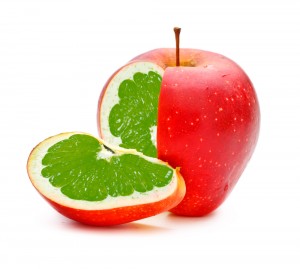
Of course, the idea that these yeast are being genetically manipulated rears it’s (block)head. For anyone who’s worried about that, it’s a non-issue. Using multiple yeast strains and sticking with the best ones has been going on for centuries, long before Pasteur came up with the germ theory of fermentation (only 150 years ago they didn’t know what yeast was: they referred to the action of fermentation as an act of god, and the middle-English used to call yeast froth ‘godisgoode’). And since they’re only working with yeast and yeast, it’s not a transgenic organism, merely an improved version–kind of like me after my morning coffee.
I for one am stoked about the whole process. We’re learning new things about the yeast we currently use, we’re going to be able to get more utility out of new strains, and the beer will be better than ever. I can’t wait to talk to Chris and his team to find out what’s coming down the pike for us homebrewers.
I bet it’s going to be great.
Neuroanthropology, Beer, and Business
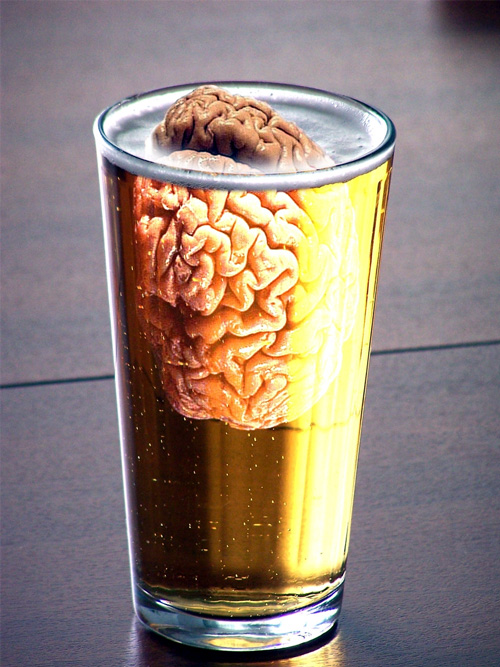
According to the Wikipedia, neuroanthropology is the study of culture and the brain. What is beer, if not culture, I always say, and yet it was a pleasant surprise to see the fellows over at the Public Library of Science Blogs saying the same thing in an entry, Carefully Crafting Consumption: Understanding the Craft Beer Revolution, where they examine (and get some experimental data on) ‘What are the driving forces behind the increased popularity of craft beer?’
It’s a good and timely question: over 400 new craft breweries opened in the last year in the USA. In my home of British Columbia we’re getting something like thirty new craft breweries a year right now–and it’s picking up every day.
Why are people so hot on craft beer–particularly at a time when macro beers (the pale, fizzy stuff that requires advertising on television) are declining precipitously? It’s so bad for the major breweries right now that they’re on incredibly aggressive acquisition schedules, buying foreign premium breweries (such as Becks) and then tossing the recipes and filling the pretty ‘imported’ bottles with BudMillerCoors Standard Western Industrial Light Lager (S.W.I.L.L.) It’s not doing them any good, mind: as soon as they acquire and ruin a new brand, sales fall off a cliff. 4th quarter sales for MillerCoors are down 2% on domestic sales. Pete Coors, chair of the Molson Coors Brewing Company and Chairman of MillerCoors summed up their problem quite succinctly in an interview with The Denver Post:
“Basically the biggest trouble we have is on-premise sales,” he said. “We have a lot of bar owners who are enamored with craft beers. They are beginning to take off the premium light handles and putting bottles behind the bar instead and replacing the handles with craft beer handles. We lose 50 percent of our volume when that happens.”
The company is trying to compel bar owners to keep their beers on tap by impressing them with facts.
“We have done research that shows it’s not in the economic benefit for a bar to do that,” he said. “Having a premium light brand, whether it’s Coors, Miller or Bud on tap actually improves the economics of their business. People stay in their seats an average of 18 minutes longer when they have a light premium beer on tap. That means they are spending more money, leaving bigger tips. We have a little algorithm and an app that we give to our distributors to evaluate and analyze these businesses and bars.”
It’s hard to be cynical enough with that series of statements. Coors is, of course, a deluded plutocrat, scion and heir to a fortune (which tends to make people quite able to deny observable reality and substitute their own) and really wants to preserve that fortune.
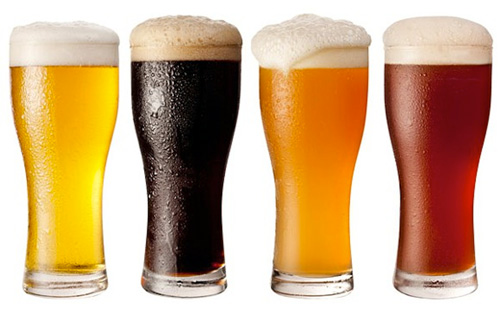
Simply put, the reason why bar owners are replacing S.W.I.L.L. with craft taps is that’s what beer consumers want. The extra 18 minutes he mentions probably comes from the fact that people can’t drink his beer fast enough because it’s ludicrously over-carbonated and they needed 15 of those 18 minutes to belch.
Back to neuroanthropology: why do craft beer lovers reject S.W.I.L.L. ? The article at PLOS is excellent and covers a lot of ground, hinging on the paradigms put forth by anthropologist Daniel Lende, who ‘proposes the following items as useful to understanding what drives consumption: sensorial, corporal, experiential, decision engaging, social, and meaningful.’
All good stuff and there’s a great bit on blind trials using different beer glasses to gauge drinkers responses to actual rather than presumed flavours and aromas, but the two most significant points pretty much cover what drives craft beer drinkers away from S.W.I.L.L. and into better beer, flavour and engagement.
Typical S.W.I.L.L. beer uses very few ingredients (one malt, one or two hops, and some sugary adjuncts), that have low flavour (rice and corn taste like almost nothing after fermentation). The sad truth about these beers is that blindfolded, the most fervent of their partisans cannot tell them apart–they are specifically designed to be as flavourless as possible–offend fewer people, grab greater sales.
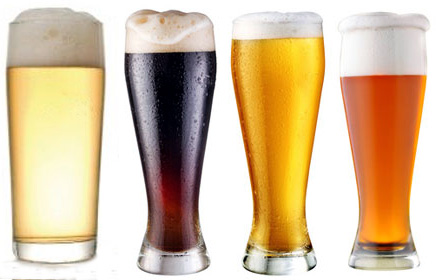
Craft beers on the other hand have the option of using many different kinds of malt–there are hundreds available–and in addition to the explosive growth of new hop varieties, they also add anything that strikes them as a positive–licorice? Sure! Coconut? You bet! And so on. They also use different yeast, and since yeast contributes heavily to the profile of a beer they can really stick the flavour knife in and twist it, adding aromas and flavours of bubblegum, melted butter or tropical fruits, if they desire. S.W.I.L.L. is universally made with alcohol-tolerant, neutral profile yeast.
All it takes is for a lover of beer is to try a few craft beers and as soon as they become normalised to the very different flavours and aromas, all S.W.I.L.L. tastes weak, watery and fizzy. It doesn’t matter if it’s the same alcohol content or the same body, the relatively weak palate of flavours and neutral character makes it wimpy.
Engagement is the second part and it’s the secret key. It’s impossible to engage with a corporation that concentrates of return for its investors above all else–no matter how many small brewers they buy, no matter how hard they try to use those breweries and their beers as a mask to try to cajole people to like their overall portfolio, it won’t work.
I engage with breweries that can tell me an authentic story about their beer–who made it, where the recipe came from, how they feel about it, and what cool stuff they’ve done and plan to do next. A corporation, designed only to make money for investors, doesn’t have a story like that, and as soon as they purchase a craft brewery they destroy its story as well.
And a corporation will never, ever understand why. Because they could be making bricks or shoes, and don’t care what the vehicle for their revenue stream is. Real craft breweries engage their drinkers with not only flavour, aroma and choice, but also with a real dedication to the idea that beer is more than just a drink–it’s a gateway to an experience.
Yet Again, Powdered Alcohol.
This is really the non-story that would not die.
You may recall from such blog posts as Powdered Alcohol: Some Dry Observations and Further Observations on Powdered Booze, the faux product Palcohol made some headlines. People who did not understand organic chemistry were delighted by the idea that there was a magic powder that you could sprinkle into anything and make it an instant alcoholic beverage, and the ‘will nobody think of the children’ crowd went absolutely insane at the idea that kids would be snorting it at parties, and next thing you know they’d be addicted to the marijuana . . .
People. I’ll never understand them. Even being one does not seem to help.
However, the chaps over at Vice Magazine (warning: the magazine and the website are relentlessly naughty) have an occasional practical bent. One of their intrepid reporters obtained the necessary ingredients and with a few modifications (he used 192 Proof grain alcohol) he made a batch.
How was it? Two quotes sum it all up:
The powder drunk creeps up on you, and sometime on the walk it kicked in. I went from mostly sober to buzzed to the kind of drunk where you already have a headache and can feel the hangover coming like a distant high-pitched whine.
The headache was still present—a throbbing pressure at my temples—but the powder drunk was giving me a weird, out-of-body feeling. If you like headaches and gummed-up sinuses and numb, dissociative (sic) drunks, you’re going to go apeshit for powdered booze.

There you have it. The author notes that the stuff burned like Napalm, which may in fact be the killer application for the product–burning up in a fire.
